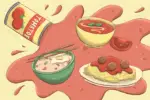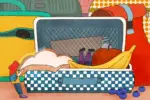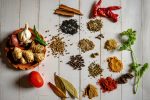This quarantine, I have begun to pride myself in learning how to cook — not just for function, but for taste. I’ve perfected my toasted croissant, egg and cheese breakfast sandwich, and a salad recipe that doesn’t taste like grass. For my snacks, I eat cherry tomatoes dipped in hummus, paired with various cheeses. Cheese is a staple in my vegetarian diet and a common ingredient in almost every dish I make; as I progress in my career as a vegetarian chef, I’ve realized that understanding the history, science and art of cheese is crucial in my journey.
The History of Cheese
To understand the current uses of cheese, we have to start at the beginning. It is believed that cheese was first discovered by the Neolithic peoples in the Fertile Crescent around 8000 BCE. Legend says that cheese was first created when a traveler accidentally stored milk in a calf’s stomach, which caused it to curdle. As early humans transitioned from nomadic hunter-gatherer lifestyles to a more settled, agricultural one, they learned to domesticate sheep, goats and cows, which were mostly raised for meat.
Humans were almost universally lactose intolerant in the past, so animal milk was harvested as a nutritional supplement for children. Milk is high in fats, protein and minerals, but easily spoils in warm weather. When milk gets turned into cheese, the sugar lactose is mostly eaten up by the fermentation process, so early people could reap the nutritional benefits of cheese without having indigestion. Cheese could also be stored and aged for long periods of time, helping people survive famines when fresh food was scarce. Because of its nutritional benefits, longevity and tastiness, cheese became a staple of Mediterranean diets and later spread all over Europe.
With the discovery of rennet, an enzyme naturally found in the guts of some mammals like cows, cheesemaking became much more diversified as the coagulation process could be controlled to create softer or harder cheeses with different tastes and aromas. Different cultures used different techniques and ingredients to uniquely flavor their regional cheeses. Mongolians used yak milk to create sun-dried cheese called byaslag. Egyptians enjoyed cottage cheese, strained with eucalyptus leaves. South Asia invented paneer, a tofu-like cheese that can be paired with curry or fried and eaten alone.
The Science of Cheese
Even though every region has its own approach to the curdling and flavoring of cheese, the same basic process is used universally. Milk, the main ingredient in cheese, is essentially made up of butterfat, milk sugar (lactose), proteins (casein and whey) and water. The solid part of the cheese is the casein and fat, while the whey is the water that is drained after the milk curdles. Varying amounts of salt, water and, most importantly, the different microbes that flourish in cheese are what flavor the cheese from their original bland curds.
The four main steps of cheesemaking are curdling the cheese, expelling the water and whey, salting and ripening. First, a bacterial culture is added to milk, which acidifies it and separates it into solid curds and liquid whey. These cultures can either contain rennet, which naturally exists in milk before pasteurization, or added acids like lemon juice or vinegar.
The water and whey is removed in order to leave the solid cheese curds. Depending on the type of cheese, the curds can go through a more thorough dehydrating process, heating the curds to evaporate more of the water in order to make drier cheeses like cheddar. Brie cheese, for example, is a wetter cheese that doesn’t need to have all its whey and water dehydrated from the curds.
Then the cheese gets shaped, salted and flavored. The salt can be rubbed on the outside of the cheese or mixed into the curds. Salting is not only for taste but for preservation as well. Salting can help keep bad bacteria at bay as well as help the cheese develop a hard, outside rind. Other flavors or spices can be mixed in and blue cheese can also be injected into the cheese. Sometimes the cheese is soaked in salt brine, as seen in the process of creating feta. Alcohols may also be used to add to the flavor and improve its longevity. Then the cheese is stored away to ripen, usually in a specific temperature or humidity until ready to eat.
Each type of cheese has its own target water content, acid content, salt content and ripening environment that influences the microbes that flourish within cheese, ultimately influencing its final aroma, texture and flavor.
The Art of Cheese
Cheese comes in a variety of flavors, from savory, home-style mac and cheese dishes, to cheesecakes, to cheeses that are paired with fruits and fine wines. This versatile food can be dressed up or down, served as an appetizer or a main course, and function as a snack or dessert. It’s no wonder that cheese is beloved by people all around the world. Since cheese has so many uses, this article is only going to focus on one important function: wine-pairing — so you can show your friends how classy and smart you are.
Cheese and wine pairings are based on complementing the cheese’s flavors and textures with the wine’s undertones and dryness. Often, pairing cheese and wines from the same location can be a good starting point. It is often believed that white wines pair better with cheese, because white wines are more acidic than reds, and have lower tannin levels. Tannins are the bitter component of wine that causes your tongue and teeth to feel “dry.” Often, fatty foods like cheese help balance out the dryness of tannins.
The WineEnthusiast breaks down European cheeses into six types in order to pair them with wines: fresh, bloomy, washed rind, semi-soft, hard, and blue.
Fresh cheeses are those that aren’t aged, so they are very soft and rindless, such as mozzarella, Boursin, feta and goat cheese. These fresh cheeses pair well with equally fresh and young (unaged) red or white wines with fruity undertones.
Bloomy cheeses have a white mold rind that surrounds a soft buttery-smooth inside that usually has a funkier, stronger flavor than the outside. This category of cheese includes brie and Camembert, which pair well with dry, sparkling white wines, or unoaked red wines like pinot noir. A classic bloomy cheese pairing with wine is Chaource cheese with Champagne.
Washed rind cheeses are bathed in beer, brine or wine, which causes them to have an orange rind. They can be soft, like Epoisses, or hard enough to grate like Gruyère. Washed rind cheeses are known to be pungent with meaty, gamey flavors. They pair best with dry unoaked white wines like Chignin Blanc.
Semi-soft cheeses aren’t good for melting or cooking with, but are often snack cheeses like Muenster, provolone and gouda. A classic semi-soft cheese pairing is Cabernet Sauvignon and aged gouda cheese.
Hard cheeses are products of long-term aging, which causes them to be brittle enough to crumble and break. They often have nutty and salty flavors and pair well with bold, aged wines. Hard cheese includes cheeses like parmesan, cheddar and pecorino. My personal favorite types of cheese are hard cheeses because they can both be used to flavor other foods or eaten by themselves. A great hard cheese and wine pairing is Pecorino Toscano and Chianti Classico.
Lastly, we have blue cheeses that are easily identifiable by their veins of blue mold that are injected into the cheese. They are extremely stinky and funky, and because of their strong salty flavors, pair well with sweet wines.
Cheese is such a versatile food, and it comes in many flavors, sizes and textures. I love that cheese can be eaten as fondue at a fancy restaurant, or shoveled into your mouth at 3 a.m. Cheese is a product of something we often see as bad; it comes from bacterial cultures and milk spoilage. But as we’ve learned, not all microbes are as dangerous as we think.
Cheese, and other fermented foods like wine, chocolate, kombucha, salami and pickles, have been safely “spoiled” to support healthy microbe growth instead of dangerous ones. Not only is cheese nutritious and delicious, but it is a beautiful product of a long history of fermentation science. As the author Clifton Fadiman famously said, “Cheese is milk’s leap toward immortality.”
















